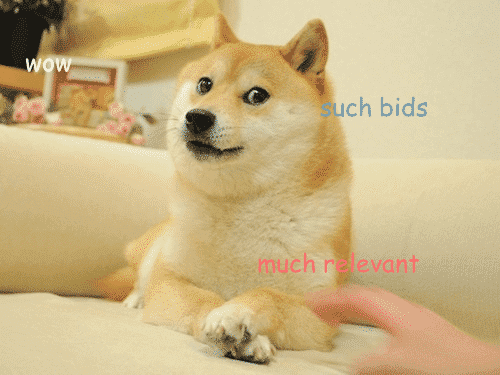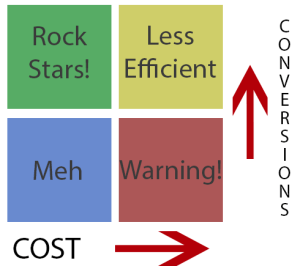When to Increase Bids in One Simple Chart
by Casey Walrath • January 30, 2014
Successfully managing bids is critical to pay-per-click success: While platforms like Google AdWords and Bing Ads have various ways to automate things for you, you’ll usually get the best results doing it yourself–as long as you do it right.
But, it’s not always easy to know when to increase bids, when to decrease them, and when to try other things. Here are a few ideas I use on my accounts.
The Four Categories of Keywords
When I got started in pay-per-click I was taught to think of keywords and ad groups in terms of their cost vs. the number of the conversions they generate. I like to organize them in a four quadrant system:
First off are the high cost, low conversion keywords in the lower right, which I’ve labeled Warning!
Your first step with these shouldn’t be to increase bids, but to figure out why the keywords aren’t working. Are they relevant? Are you bidding too much? Are they worth bidding on at all? If these keywords aren’t helping you reach profitable returns, then you should consider decreasing their bids or pausing them.
In the upper-right hand corner, you’ve got your high cost, high conversion keywords, which I’ve called Less Efficient. These keywords might not be exactly relevant to your ads or landing pages, or they just might be very competitive.
Deciding when to increase bids depends on whether they’re meeting your goals. Usually you’ll want to improve other areas: Can you write better ads? Can you improve your landing page? Can you improve your Quality Scores? Once you’ve done all that you can think about increasing bids.
In the lower-left are low cost, low conversion keywords, which I’ve labeled Meh. These might be long-tail or less popular queries, or just too competitive for your current bid levels. Either way they’re not doing much for your account.
If your ad position is bad, increasing bids might improve your presence and get you more clicks—just be sure to watch that these keywords don’t slide into the Warning or Less Efficient categories.
Finally, in the upper-left are the Rock Stars!, which deliver lots of conversions at a low cost. When you’re deciding out when to increase bids the Rock Stars can be a good place to start.
Increasing bids will usually increase your cost per conversion, but if that increases profitability then that’s fine. Just be careful to make changes in small increments and test thoroughly: sometimes keywords hit a sweet spot where increased bids no longer help anymore.
Besides those four quadrants, here are a few other ppc guidelines for when to increase bids and when to decrease them:
What’s Your Average Ad Position?
If your average position is 1.1, then increasing bids won’t do much, but if you’re at 5.5 then you’ve got room to grow. Don’t always assume that the #1 ad position is the best, however. Depending on your budget and your product you might find that a lower position is more profitable.
Check Your Budget
If you’re reaching your daily budget, there’s often no point increasing bids: you’ll just hit your budget faster. In fact, if your budget is fixed then sometimes decreasing bids will actually result in more clicks and conversions.
Scour for Negative Keywords
Use the Search Query report to make sure your ads aren’t triggering for irrelevant searches, and look for new negative keywords regularly. Sometimes the key to making a Less Efficient keyword a Rock Star is adding more negative keywords to improve its efficiency and relevance.
Don’t Forget Phone Calls!
Finally, remember that ad clicks aren’t always everything. If you’ve got call extensions setup then they’re much more likely to be seen in higher ad positions. If your goal is to get calls, increasing bids for a better ad position might drive enough calls to justify the higher cost. Be sure that you’ve got call tracking setup so you can measure the results!
Follow these handy guidelines while you’re deciding how and when to increase bids and you’ll be on your way to becoming a PPC master!






